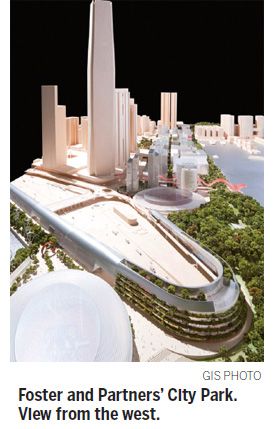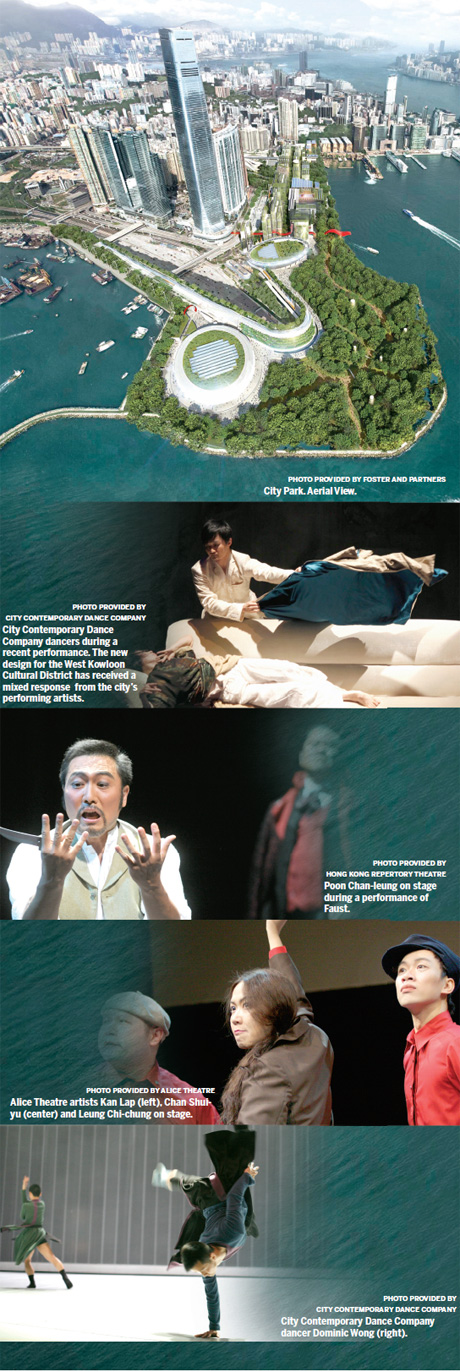Art without artists
Updated: 2011-04-12 06:57
By Steven Chen(HK Edition)
|
|||||||||

The West Kowloon arts hub promises to be another showpiece for the city. But the artists, for whom the place was supposed to be designed, say the plans are so upscale that there will be little room left for them in the new arts hub. Steven Chen reports.
After a drawn-out selection process for the master plan and much heated debate, Hong Kong's West Kowloon Cultural District is once again moving forward.
Foster and Partners' winning design for the HK$21.6 billion arts hub is vastly different to the other entrants in the design competition. "City Park", as it was dubbed, envisioned a great "park", a tree-lined waterfront promenade and urban quarter featuring 17 arts facilities. Dutch architect Rem Koolhaas had proposed his edgier "Project for a New Dimension", an urban village that proposed concepts outside the design program. Local architect Rocco Yim's "Cultural Connect" was rejected because its staggered layout was viewed as inhibiting interactions in the public space.
While the city's leading government officials, arts committee members and entrepreneurs weighed in with their views during the judging phase, one voice that was notably missing was that of the artists themselves.
"Very imposing," says Poon Chan-leung, a veteran of the local performing arts scene, of the proposed design. Poon, a full time actor with the Hong Kong Repertory Theatre, says he believes the city is more interested in creating a commercial enterprise than a genuine arts hub.
"Investment in the arts hub should be an investment in the arts, not in development. An arts hub should not be judged by how many visitors it attracts, or how many theaters it has. But that seems to be the priority here. I'm worried that most people will think of the place as a leisure center, not a place for the performing arts."
Poon says he believes part of the problem is the government's history of letting commercial concerns take priority over public interest. "The truth is that, in Hong Kong, most people don't want more theaters, they want more space."
"Too much," says Andrew Chan Hang-fai, artistic director of Alice Theatre, a small theater group that he runs with actress and partner Chan Shui-yu, out of an industrial estate in Kowloon.
"Overall, the plan looks very dense. I see shops and an arts district, more like an entertainment centre, not a place for the arts. I am afraid it will just be a commercial development."
"The arts hub looks like it will be a place for big local stars, overseas artists and big musicals," says Chan Shui-yu. "We are always trying to import everything but this will not help (small) local artists. We need to develop our own (arts) culture."
Despite teaching all day before meeting her team for rehearsals and management duties late into the night, life in the theater is a constant struggle for her and her small team, she admits. It doesn't help at all that the government recently removed fees applying to a change of use on properties over 15 years old in industrial estates. Unpopular spaces like the one occupied by Chan's theater suddenly have become potential money makers for owners.
"At least half of our (Arts Development Council) grant goes on rent, about HK$18,000 a month. The tenants next to us just had their rent raised, from HK$5,000 to HK$18,000 too. With all our other expenses and small tickets sales, it's difficult."
Rather than building an upmarket arts district with multi-million dollar architectural masterpieces, "more money should be used to help artists themselves", says Chan Hang-fai.
A spokesperson for the West Kowloon Cultural District Authority (WKCDA) offers the following reply: "After deliberating for 15 months in close and intensive consultation with the local arts community and related parties, the Consultative Committee recommended developing 15 performing arts venues and at least three hectares of piazza areas."
In a brief, "City Park" designers Foster and Partners says: "Cities are defined by their parks, their public spaces, their streets, their laneways, by their ordinary buildings and their civic jewels. We have created the framework for an urban quarter in West Kowloon with all these ingredients."
Chan Shui-yu's concerns touch on another aspect of the design - the texture of the "urban quarter". Organized along a central pedestrians-only avenue, the layout of the facilities in the zone extends adjacent street patterns into the site. It is designed to be true to the scale and character of the city.
While the artists agreed that having the venues together was convenient, there were concerns about their size and the density of the project.
"Small theaters like ours have only a small following," says Chan Shui-yu. "Just 80 to less than 200 people. Our shows have a lot of interaction with the audience. We are also looking at holding drama workshops and classes, like we do in our (primary and secondary school) classes. This is how we try to promote ourselves and build up our audience."
Ideally, "each company should have its own theater," says Chan Hung-fai. "It gives them a chance to develop a relationship with the audience. This takes time. We don't need a big venue. With our shows, small theaters work well."
Tysan Chak Hoi-tai says, "Each group should have a long-term tenancy at a venue, or at least be able to lease a venue for several (different) productions." He is an actor with PIP Cultural Industries, one of Hong Kong's best known and most popular theater groups currently riding high on the success of its hit comedy Microsex Office.
"We need time for our audiences to get to know us, but this won't happen if (resident) artists keep changing."
Chan Hang-fai says, "I was hoping the arts hub would be like a village."
"Artists' studios with a mix of tenants, coffee houses, bookstores, where artists, dancers, poets could meet each other and interact. The essence of arts and expression develops in these places."
Poon, who says he's been "lucky" to have worked almost uninterruptedly during his 20 years in the business, unlike many of his peers, says the government's tight grip on venues means too much control is not by the artists.
"The government owns all the (major) venues so anyone that wants to put on a show has to go through them. We need private theatres so we can have more independence. Local audiences also need to learn to appreciate small shows. If we have big theaters we need to charge high ticket prices. But if we charge more for tickets, they (audiences) want big stars on stage."
Says the WKCDA: "To cater to different types of performances and events, facilities recommended to be provided include performing arts venues of various types and sizes. The Consultative Committee recommended developing the district as a low-density development with ample open space."
Says Foster and Partners: "Most of the venues are small (100-800 seats) and medium theaters and music halls (1,000-2,200 seats). Only one venue, the Mega Performance venue, caters for larger crowds with a capacity of 15,000 seats. The very tall International Commerce Centre and Union Square development will be backdrops to the low-rise WKCD. Right now we are working on the master plan. We aim to consult the arts and creative community as we develop this."
Much has been made of one of the design's key features - the huge green space at the west end of the site. The 19 hectare park with over 5,000 trees is intended to be another "lung" for the city and a place for outdoor activities and vibrant artistic and social interactions.
"I'm concerned that people like the park but won't care about the venues," says Poon. "Will people go to the park then watch a performance or will they do tai chi or play sport and then go home? The park needs to have a direct relation to the arts facilities to get people involved."
Chan Hang-fai says, "I like the park but it is almost too big and the venues are separated."
"Is there anything happening 'here' that is related to the venues? I would like to see more integration so the park also feels like it is for the arts."
Says the WKCDA: "The park and open space proposed in Foster's scheme allow room to accommodate outdoor arts and cultural activities."
Says Foster and Partners: "The 19 hectare park brings the sights, sounds and senses of Hong Kong's hinterland into the heart of the city and will be the first part of the district to open. Some of the things you will be able to do are relax in a tranquil sculpture garden, have tea in a pavilion, or enjoy a picnic on the waterfront. For us the park is a cultural venue."
One artist who feels the criticisms are too harsh is Domenic Wong, a full-time dancer with City Contemporary Dance Company. Like many of his classmates, Wong struggled to support himself in the years after he graduated.
"When I was starting, there were very little opportunities. It's very hard to get into one of the three dance companies and more than half my classmates quit because there were no jobs. Now there is more work because drama and dance have been included in (primary and secondary) schools, so dancers can teach to support themselves. I think what the government has done is good. Any efforts to help the arts are a good thing."
In selecting City Park, with its showpiece venues, "the government has made a safe choice", says Poon. "This precinct is just the kind of thing they (government) like. Big venues, carefully (prudently) managed. I was hoping for something 'crazy' but that stage is over now. Now we have to see what happens with the software."

(HK Edition 04/12/2011 page4)